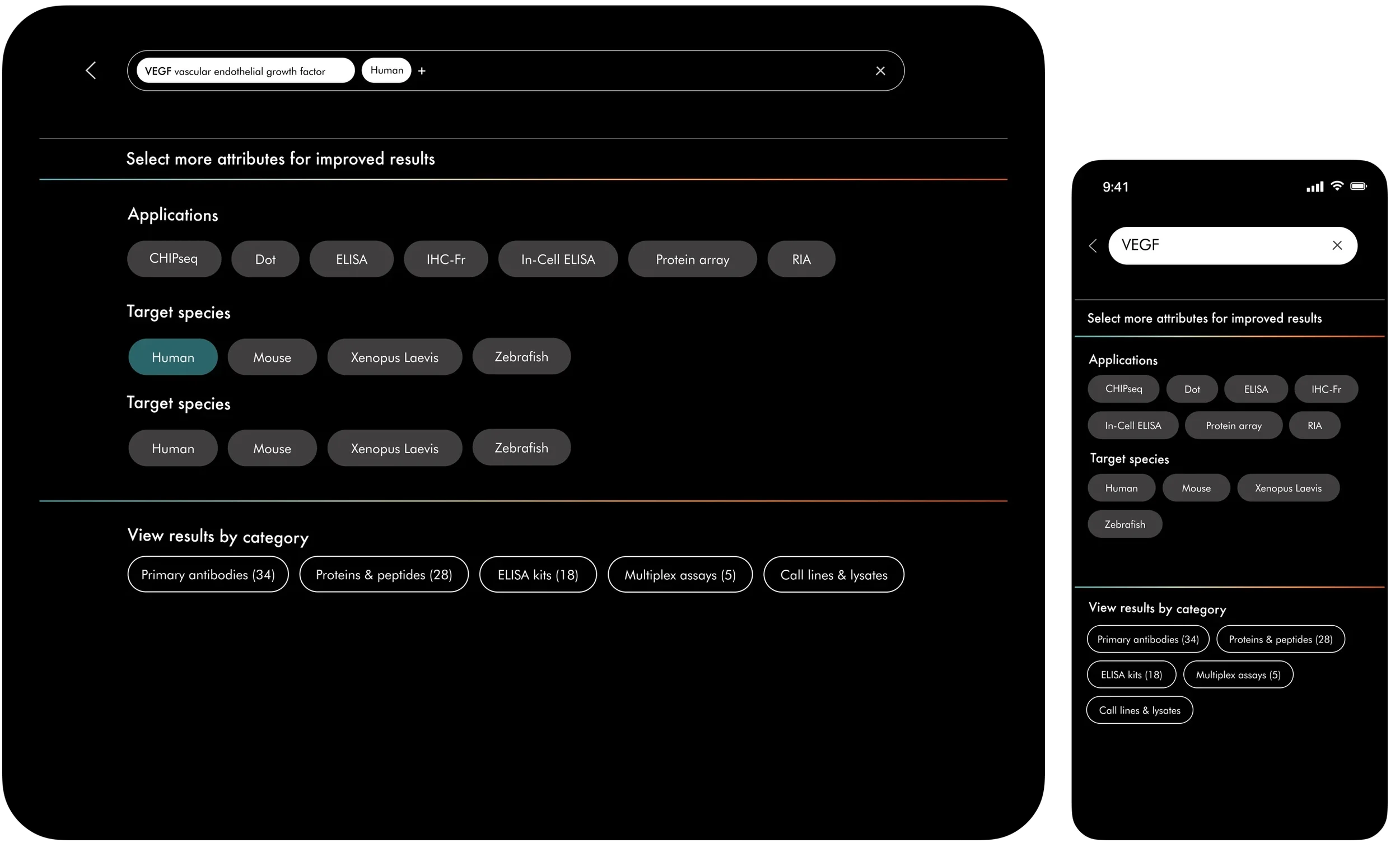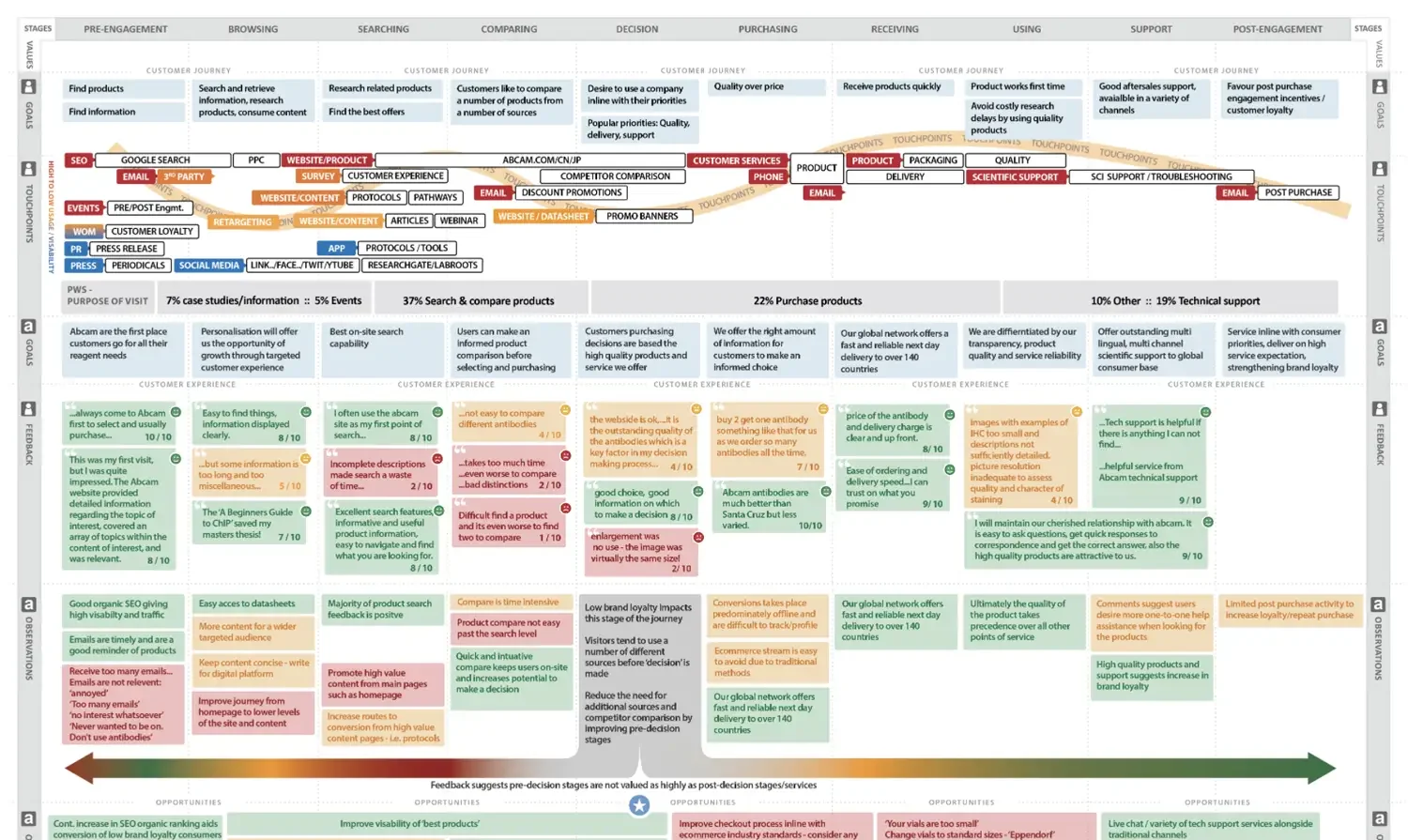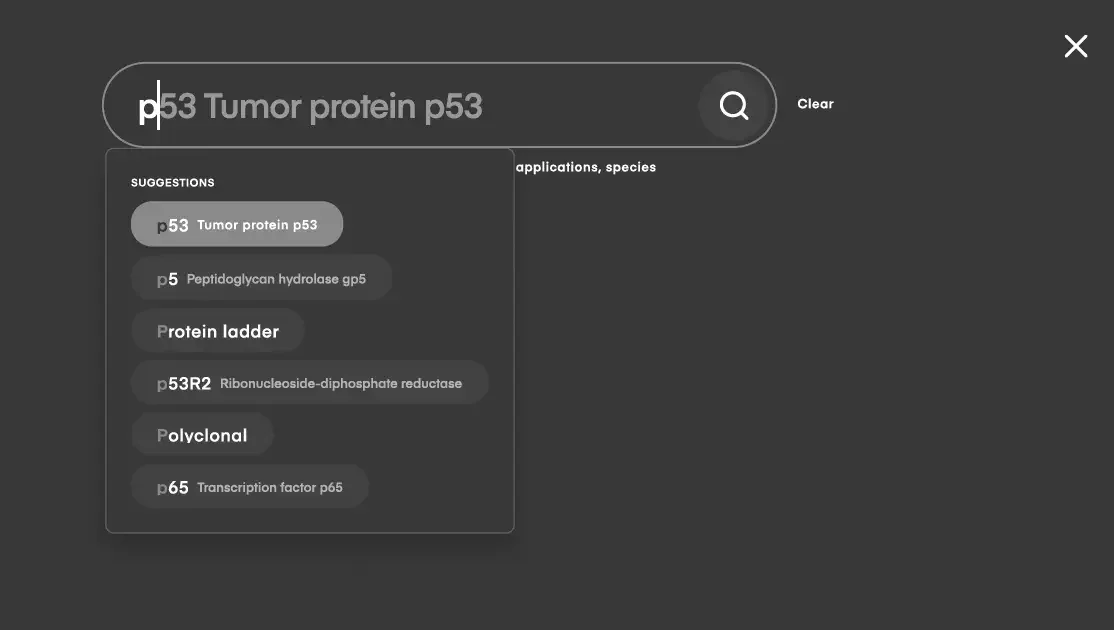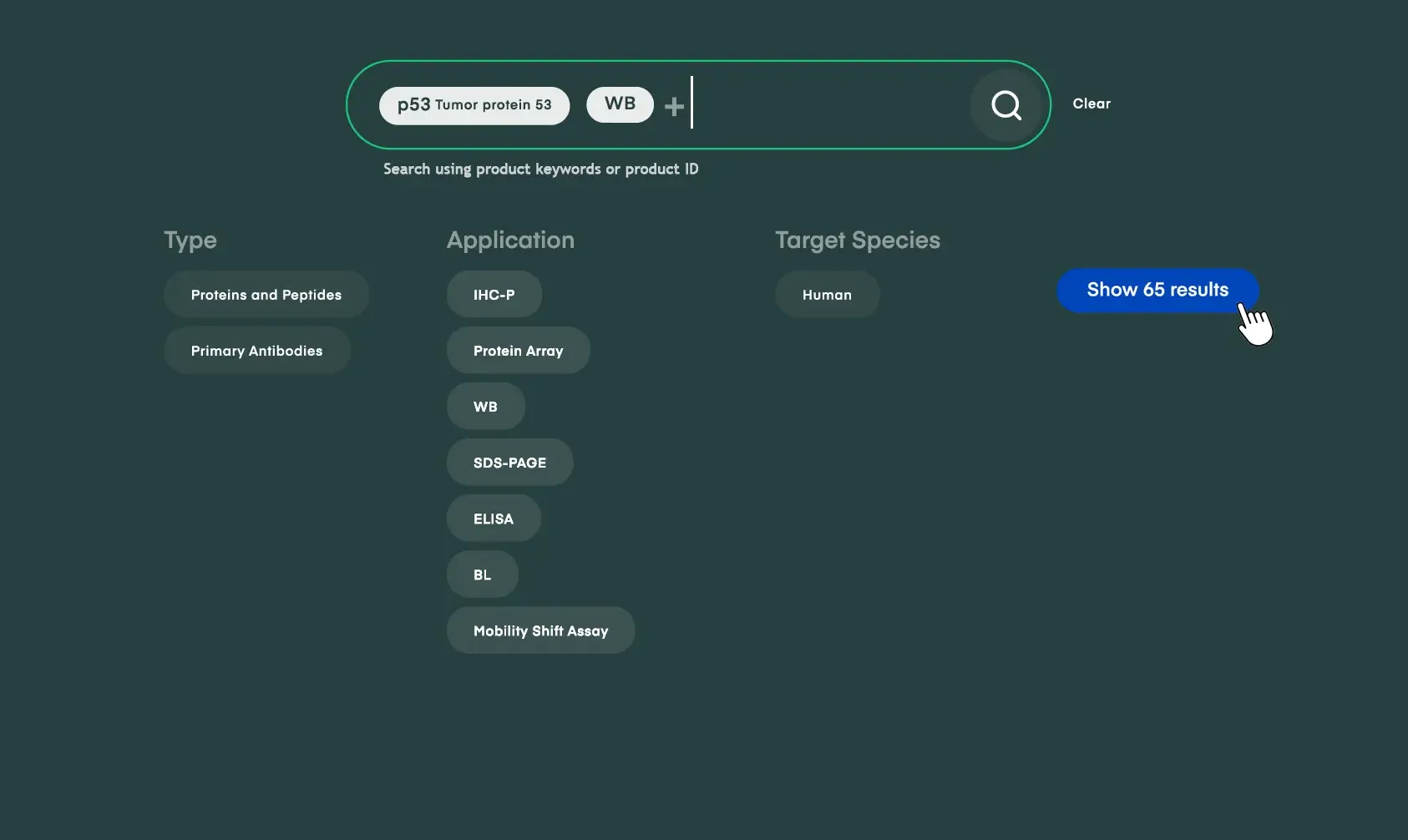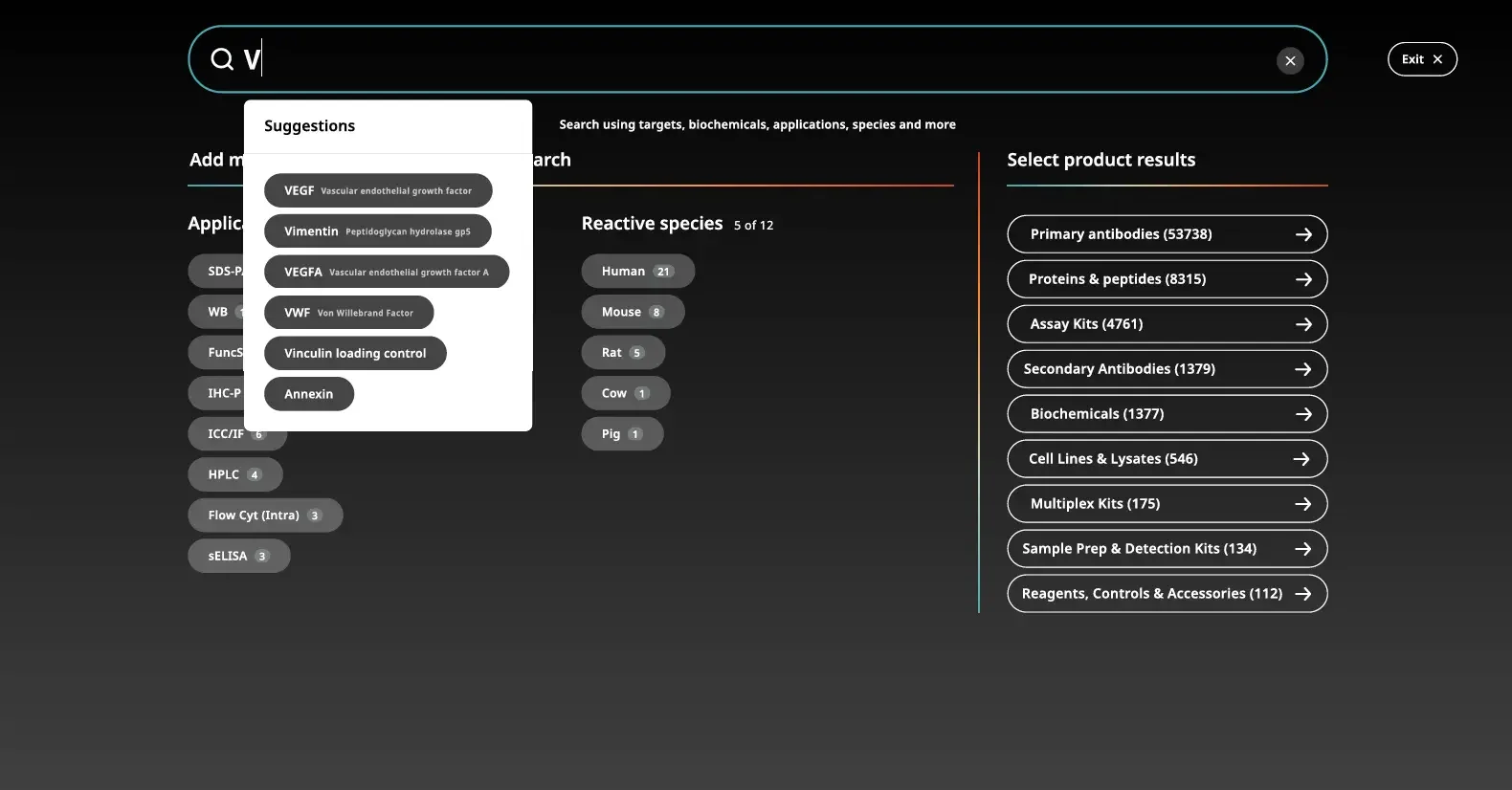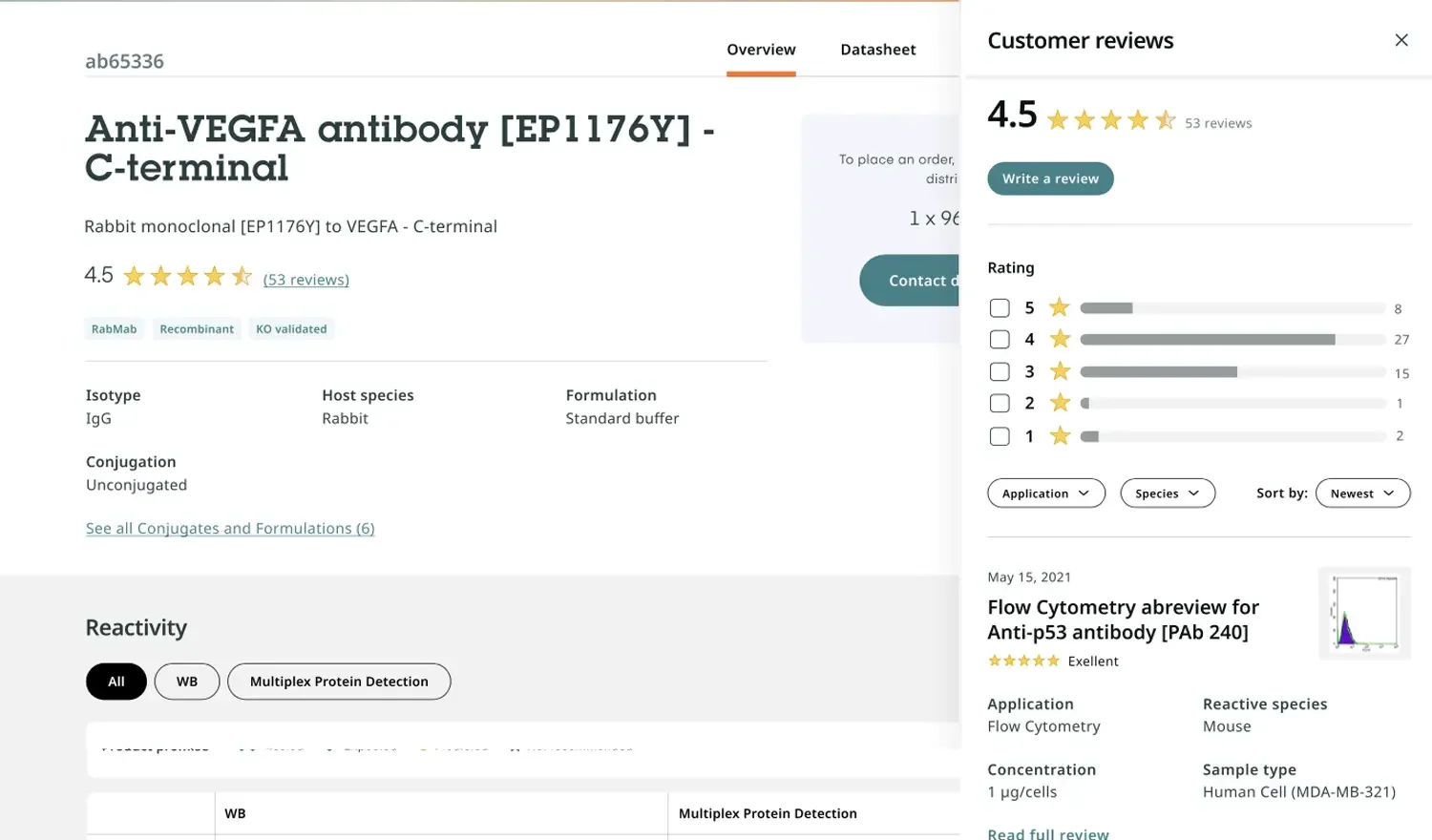Right product, first time
Improving search capability through behaviour change, increasing result relevancy and efficiency
Leading B2B2C bioscience provider of research products
Trusted by global researchers via validation data, peer reviews and citations
~750,000 researchers / ~110K products / ~130+ countries
Initiative
End-to-end e-commerce customer experience redesign
New e-commerce platform and modernised journeys across:
Search, Engagement, Customer Accounts, E-commerce and Customer AssistIncreasing result relevancy to customer needs
Note - This summary highlights the core search-to-conversion journey within the broader transformation initiative
Role
Created UX strategy and design ops model for end-to-end e-commerce replatform initiative (search to checkout)
Recruited, scaled, and managed UX team (design, research, insights, IA, copy, design operations)
Defined strategy hypotheses - Low filter engagement, positive friction, right product - first time
Delivered research roadmap and insight outcomes supporting all product squads
Advocated user-centred outcomes aligned to revenue - Prioritising search improvement and accuracy
Partnered with product management, engineering, data science, delivery, and customer-facing teams
Mentored team, advocating design discovery; customer journey mapping as a core source of insights, cross-validated with contextual user feedback and testing
Managed stakeholder design scope and expectations - UDX, brand and research
Explored AI/ML alternative search capability and tools with Data Science leadership and teams
Search challenge
Time-poor researchers overwhelmed by results in categories of up to 30,000+ products
Complex products contributed up to 50+ filters with <~4% engagement
99% of top searches were largely target-only entries, reducing search effectiveness and bloating results
Contextual research revealed time-poor environments resulting in fast product decisions
Avg. customer viewing 1.2 pages per session (~24 products), leaving relevant products undiscovered
Search objective
Ensure customers reviewed all relevant products available to their need
Enable customers to find the right product, first time (single session)
Early outcomes
Product Description Page (PDP) engagement:
Quick view included in new formula representing key product attribute views influencing purchase
PDP engagement improved by 30% (1.2 → 1.6 per session, ~2.8M/year) if sustained
CSAT: Increased from 3.2 → 4.3/5
Quick View: Reduced irrelevant product visits, surfacing attributes earlier in the customer journey
Product relevancy: Improvements lowered replacements under guarantee, reducing avoidable costs and strengthening trust
Bounce rate: Held steady at ~50%, within e-commerce benchmarks, despite added positive friction
Why product views mattered
Mixed on/offline purchasing = views were the strongest proxy to conversion / revenue increase
Fewer product replacements when customers exposed to relevant product attributes
Research & discovery
“Future opportunities for experience improvements and growth are often found in existing customer feedback data”
Methods
Data (sessions, bounce, filter use, PDP views)
Interviews, usability tests, surveys, sentiment tracking
~300 customer engagements, ~10k+ customer feedbacks across initiative (direct & distributor markets) as part of 200k feedback repository for UXR analysis
CSAT, continuous feedback loops, session analysis, heatmaps
Internal UAT, BETA testing and leadership reporting
UX end-to-end prototype research
Private BETA (x1 market) followed by public BETA (x3 markets)
Key insights
Bounce ~50%
Search filter use correlated with higher PDP engagement, but customer filter adoption <4%
Time poor researchers on average skipped refinements and went direct to product pages
Researchers required key product attributes upfront
Discovery confirmed focus: fewer results, higher product relevancy
Design approach & solution exploration
Concepts & prototyping
Pre-search autosuggest expanded from single-word searches with product attribute prompts for highly relevant results
Product Quick View surfaced essential attributes, reducing back and forth between result and dense product pages
Parent category fallback ensured continuity for broad searchers, supporting legacy behaviours at no risk to revenue
Iterations & Trade-offs:
“Just one extra experiment attribute prior to search narrowed results, and was a step closer to their and our objective: Right product, first time”
Positive friction: Customers invested fractionally more time pre-search, saving time later at the higher pressure stage of product selection
Filter simplification: Complex products contributed to 50+ options which were reduced to essentials only, shifting away from unused filters
Mid-project rebrand: Increased timescales and UX resource required to collaborate and create a new version of the design system
Customer journey map indicates a better post-decision experience (right) and shows a visible increase in negative feedback for pre-decision stages (left)
Customer feedback revealed time-poor sessions and quick product selection
Customer feedback supported priority product iteration
Improving autosuggest became a priority focus after UXR feedback
BETA: Additional user inputs returned more relevant results
Implementation
Hypotheses validated through contextual research, customer surveys, sentiment tracking, usability tests, beta trials and leadership feedback
UXD & UXR embedded across Product & Engineering squads
2 week sprints following product area roadmaps
Stakeholder collaboration contributed to peer and customer focused improvements
Phased rollout
Single European market pilot
Expanded across EMEA
Similar pilot repeated before full APAC region
Rolled-out in US after strong results
UX collaborated with; PMs, engineers, delivery managers, customer support, sales and marketing stakeholders
Full-screen branded overlay resulted in focused search sessions
Shifting time factor upfront: Resulted in less friction at the decision stag
Results
Quantitative
PDP sessions:
Quick view included in new formula surfacing key product attributes required for or influencing purchase decisions
Search to PDP engagement improved by 30% (1.2 → 1.6 per session, +2.8M sessions/year) if sustained
CSAT: 3.2 → 4.3/5 as a result of improving search, exposing product attributes earlier and reducing search to decision overhead
Bounce rate: Held steady at ~50% despite added positive friction
Filter use: Remained low <4%, but offset by stronger product signals via expanded autosuggest (and Quick View PDP-equivalent engagement)
Search abandonment rate: Zero results improvement 7% as a result of a work stream designated to improving zero search results and direct keyword to product matching
Qualitative
Customers found products faster with greater confidence
Quick View reduced irrelevant PDP visits and exposed attributes earlier
Stakeholders observed fewer product guarantee replacements
Positive beta testing feedback supported global rollout
Business Impact
Higher product views correlated with revenue growth
Reduced replacements lowered avoidable costs and strengthened customer trust
Reinforced business positioning as a digital-first provider
Learnings & Next Steps
Successes
Autosuggest & Quick View improved results relevancy
Increased product views / year and improved customer satisfaction
Surfacing reviews and validation data earlier in the customer journey saved customers time
Challenges & Learnings
Mid-project rebrand overhead
Scope expansions extended initiative timescales
Distributor journey improvement required where Quick View not required (primarily repurchase of known products)
Achievable using identified, signed-in distributor sessions
Acquisition deprioritised digital focus
Next Steps
Personalised autosuggest - segmentation, signed-in state and purchase history recommendations
Explore AI/ML product trend predictions - identify trending products to inform manufacturing and marketing decisions
Continue to improve fuzzy matching across mixed keyword and autosuggest searches
UXR: Behaviour data, customer feedback and sentiment tracking
Quick View exposed product attributes without click-thru friction
Component reuse: Consistency and retained user context

